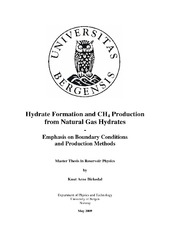| dc.description.abstract | Natural gas hydrate is a solid state of gas and water at low temperature and high pressure. Gas hydrates are known to form hydrate plugs in production line, and has thus generally been considered a problem to the oil industry. However, the energy stored in gas hydrates is vast, and as the global energy demand increases, focus is shifted on gas hydrates as a potential energy resource. The work presented in this thesis is a series of experimental studies of hydrate formation and dissociation kinetics in porous sandstone. The overall objective was to provide an improved basic understanding of processes involved with formation and production of methane (CH4) gas hydrates within porous media and to obtain data for numerical modelling and scaling. CH4 hydrate has been formed repeatedly in Bentheim sandstone rocks to study hydrate formation patterns as function of initial water and gas saturations and salinity, and to prepare for subsequent lab-scale gas production tests using two different production schemes: 1) CH4 production by carbon dioxide replacement, and 2) CH4 production by dissociation of hydrates through depressurization. Salinity impacts on induction time and hydrate growth pattern has been investigated through six different experiments, looking at the effect of salinities ranging between 1 wt% and 10 wt%. Salts are well known hydrate inhibitors and may affect both induction time for nucleation and hydrate growth pattern. These results show that salinities below 4 wt% NaCl do not seem to affect the hydrate formation rate significantly. However, at higher salinities (4.5-10 wt% NaCl) the inhibition is evident. The results show a reduction of the amount of water converted to gas hydrates and an increase in induction time with increasing salinity. Depressurization is by many considered the most promising production method, and is the only successful production method to date on field scale (The Messoyaka field located in the eastern Siberian permafrost). This production method is based on dissociation of gas hydrate by bringing the reservoir below the hydration pressure. In this work CH4 was produced from Bentheim sandstone partly saturated with gas hydrate by reducing the pressure stepwise until dissociation commenced. The production was monitored both by in situ magnetic resonance imaging (MRI), and by material balance calculations from PVT data. Results were consistent with previous results (Husebø et al., 2008b), which indicates reproducibility of the experiment, and showed full recovery after 280 hours. Production of associated water was detected. The second production scheme investigated was CH4 production by exchange with carbon dioxide. When CH4 hydrate is exposed to CO2 an exchange of gas molecules will occur spontaneously, as CO2-hydrate is the thermodynamic preferred hydrate. The molecular exchange process release CH4 which can be made accessible for production. In this thesis experiments take advantage of MRI technology to monitor the in situ CH4 release. Significant gas production was observed and corroborated previous reported experiments with recovery estimates between 50-85%. No hydrate dissociation was detected, and consequently no production of associated water was observed. In the experiments conducted as part of this thesis, most of the water was converted into gas hydrates when the system was pressurized and brought below hydrate formation temperature.... | en_US |
